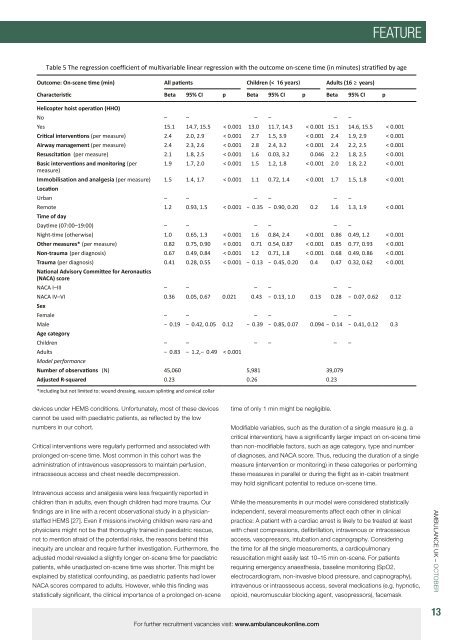Ambulance UK October 2023
You also want an ePaper? Increase the reach of your titles
YUMPU automatically turns print PDFs into web optimized ePapers that Google loves.
FEATURE<br />
Table 5 The regression coefficient of multivariable linear regression with the outcome on-scene time (in minutes) stratified by age<br />
Outcome: On-scene time (min) All patients Children (< Adults (16 ≥ years)<br />
Characteristic Beta 95% CI p Beta 95% CI p Beta 95% CI p<br />
Helicopter hoist operation (HHO)<br />
No – – – – – –<br />
Yes 15.1 14.7, 15.5 < 0.001 13.0 11.7, 14.3 < 0.001 15.1 14.6, 15.5 < 0.001<br />
Critical interventions (per measure) 2.4 2.0, 2.9 < 0.001 2.7 1.5, 3.9 < 0.001 2.4 1.9, 2.9 < 0.001<br />
Airway management (per measure) 2.4 2.3, 2.6 < 0.001 2.8 2.4, 3.2 < 0.001 2.4 2.2, 2.5 < 0.001<br />
Resuscitation (per measure) 2.1 1.8, 2.5 < 0.001 1.6 0.03, 3.2 0.046 2.2 1.8, 2.5 < 0.001<br />
Basic interventions and monitoring (per<br />
measure)<br />
Location<br />
*including but not limited to: wound dressing, vacuum splinting and cervical collar<br />
1.9 1.7, 2.0 < 0.001 1.5 1.2, 1.8 < 0.001 2.0 1.8, 2.2 < 0.001<br />
(per measure) 1.5 1.4, 1.7 < 0.001 1.1 0.72, 1.4 < 0.001 1.7 1.5, 1.8 < 0.001<br />
Urban – – – – – –<br />
Remote 1.2 0.93, 1.5 < 0.001 − 0.35 − 0.90, 0.20 0.2 1.6 1.3, 1.9 < 0.001<br />
Time of day<br />
Daytime (07:00–19:00) – – – – – –<br />
Night-time (otherwise) 1.0 0.65, 1.3 < 0.001 1.6 0.84, 2.4 < 0.001 0.86 0.49, 1.2 < 0.001<br />
Other measures* (per measure) 0.82 0.75, 0.90 < 0.001 0.71 0.54, 0.87 < 0.001 0.85 0.77, 0.93 < 0.001<br />
Non-trauma (per diagnosis) 0.67 0.49, 0.84 < 0.001 1.2 0.71, 1.8 < 0.001 0.68 0.49, 0.86 < 0.001<br />
Trauma (per diagnosis) 0.41 0.28, 0.55 < 0.001 − 0.13 − 0.45, 0.20 0.4 0.47 0.32, 0.62 < 0.001<br />
National Advisory Committee for Aeronautics<br />
(NACA) score<br />
NACA I–III – – – – – –<br />
NACA IV–VI 0.36 0.05, 0.67 0.021 0.43 − 0.13, 1.0 0.13 0.28 − 0.07, 0.62 0.12<br />
Sex<br />
Female – – – – – –<br />
Male − 0.19 − 0.42, 0.05 0.12 − 0.39 − 0.85, 0.07 0.094 − 0.14 − 0.41, 0.12 0.3<br />
Age category<br />
Children – – – – – –<br />
Adults − 0.83 − 1.2, − 0.49 < 0.001<br />
Model performance<br />
Number of observations (N) 45,060 5,981 39,079<br />
Adjusted R-squared 0.23 0.26 0.23<br />
devices under HEMS conditions. Unfortunately, most of these devices<br />
cannot be used with paediatric patients, as reflected by the low<br />
numbers in our cohort.<br />
Critical interventions were regularly performed and associated with<br />
prolonged on-scene time. Most common in this cohort was the<br />
administration of intravenous vasopressors to maintain perfusion,<br />
intraosseous access and chest needle decompression.<br />
Intravenous access and analgesia were less frequently reported in<br />
children than in adults, even though children had more trauma. Our<br />
findings are in line with a recent observational study in a physicianstaffed<br />
HEMS [27]. Even if missions involving children were rare and<br />
physicians might not be that thoroughly trained in paediatric rescue,<br />
not to mention afraid of the potential risks, the reasons behind this<br />
inequity are unclear and require further investigation. Furthermore, the<br />
adjusted model revealed a slightly longer on-scene time for paediatric<br />
patients, while unadjusted on-scene time was shorter. This might be<br />
explained by statistical confounding, as paediatric patients had lower<br />
NACA scores compared to adults. However, while this finding was<br />
statistically significant, the clinical importance of a prolonged on-scene<br />
time of only 1 min might be negligible.<br />
Modifiable variables, such as the duration of a single measure (e.g. a<br />
critical intervention), have a significantly larger impact on on-scene time<br />
than non-modifiable factors, such as age category, type and number<br />
of diagnoses, and NACA score. Thus, reducing the duration of a single<br />
measure (intervention or monitoring) in these categories or performing<br />
these measures in parallel or during the flight as in-cabin treatment<br />
may hold significant potential to reduce on-scene time.<br />
While the measurements in our model were considered statistically<br />
independent, several measurements affect each other in clinical<br />
practice: A patient with a cardiac arrest is likely to be treated at least<br />
with chest compressions, defibrillation, intravenous or intraosseous<br />
access, vasopressors, intubation and capnography. Considering<br />
the time for all the single measurements, a cardiopulmonary<br />
resuscitation might easily last 10–15 min on-scene. For patients<br />
requiring emergency anaesthesia, baseline monitoring (SpO2,<br />
electrocardiogram, non-invasive blood pressure, and capnography),<br />
intravenous or intraosseous access, several medications (e.g. hypnotic,<br />
opioid, neuromuscular blocking agent, vasopressors), facemask<br />
AMBULANCE <strong>UK</strong> – OCTOBER<br />
For further recruitment vacancies visit: www.ambulanceukonline.com<br />
13
















